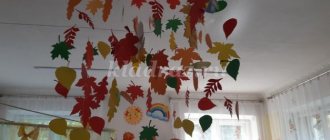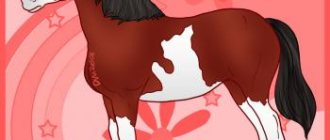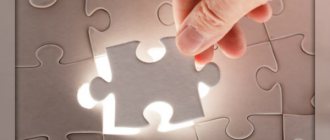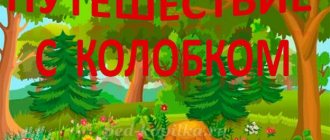Notes on the world around us for the younger group in kindergarten. Pets and their babies
Summary of a lesson on the surrounding world for younger preschoolers “Pets and their cubs”
I present to your attention a summary of a lesson on the surrounding world for teachers of the 2nd junior group on the topic “Pets and their cubs”. The lesson is designed for children 3-4 years old. I conducted this lesson with children at the beginning of the week on the lexical topic “Pets”, in the morning, the lesson lasts 15 minutes. Goal: to introduce children to domestic animals and their cubs. Objectives: 1. learn to name pets; 2. teach to compare animals by size; 3. develop memory, love for animals; 4. develop attention and speech; 5. activate and enrich your vocabulary. Planned result: 1. be able to guess riddles based on verbal descriptions; 2. teach how to look at illustrations; 3. be able to talk about what is shown in the picture. Progress of the lesson: Educator: Hello, guys. Today different animals came to visit us. (on the magnetic board there are images of animals: cow, cat, horse, dog) Listen to the riddles and try to guess the names of the animals. Riddle 1 - She has horns, hooves, and looks angrily at everyone. But she is kinder than a puppy, and will pour us milk. Children: Cow . Educator: Well done guys, that's right, cow! (I show a picture of a cow). I say that the cow has what on its head? - Horns, eyes, ears, mouth. The cow chews grass and gives milk! Riddle 2 - He’s crying at the threshold, hiding his claws. He will quietly enter the room, purr, and sing. Children: Cat, cat. Educator: That's right, cat. (I show a picture of a cat) I say that a cat has ears, eyes, a nose, a mouth and whiskers on its head. The cat catches mice, it is pleasant to stroke its fur. Riddle 3 - I have a big mane, ears and hooves. I'll give him a playful ride, who isn't afraid. My fur is smooth, Who am I?... Children: Horse . Educator: That's right, guys. (I show a picture of a horse). I say that the horse has a mane, tail and hooves. You can ride a horse. Riddle 4 - Lives in the yard, In a private house-kennel, And at everyone she doesn’t know, She either growls or barks. Children: Dog . Educator: Dog, well done guys. (I show a picture of a dog). I say that the dog has 4 legs, a tail, and ears. A dog is a person’s friend, it guards the house, you can go hunting with it. Educator : Well done, guys, you guessed all our guests. What can you call all these animals? What are they? Children: Homemade Teacher: Why are they called homemade? Children: Because they live in the house and in the yard. Educator: That's right, guys. And I also have pictures of their cubs. The only problem is, they are all mixed up. Let's try to give each animal its own baby, shall we? Educator: The dog has a small... puppy
.
Katya, go to the board and take the little puppy to your mother. (the child attaches a picture of a puppy to a dog). And the cat has a small... kitten
.
Olya, go to the board and help the little kitten find its mother. (the child attaches a picture of a kitten to a cat). The cow has a small... calf
.
Sasha, come out and take the little calf to your mother. (the child attaches a picture of a calf to a cow). The horse has a small... foal
.
Seryozha, go to the board and help the little foal find its mother. (the child attaches a picture of a foal to a horse). Educator: Guys, tell me, do you know how animals take care of their young? They feed them milk, clean their fur with their tongue, protect and warm them. How do animals take care of their young? Children: repeat the teacher’s answer. Physics minute “Kitty”: Here’s a kitten, sneaking around in a circle, one after another on its tiptoes.
Round face,
stop, show the face with both hands, shake their head.
And on each paw
they rhythmically extend their left hand, then their right.
Scratchy claws.
All his toys are jumping on their toes, holding their hands on their belts.
Cube and reels.
The cat, like a ball, bounces and moves in a circle one after another.
Jumps around the apartment.
Game "Feed the animals" . A kitten and a puppy are sitting on the table. Educator: Guys, tell me, what do you think the kitten likes to eat? Children: milk, sour cream. Educator: That's right, guys. I invite one child to bring a toy plate, another to “pour” milk from a bottle, and a third to place the plate near the cat. Guys, what do you think the puppy likes? Children: bones, bread. Educator: Good guys, guys. Let's feed our puppy too. I suggest feeding him a bagel. Educator: The kitten and puppy ate and went to bed. And it's time for us to finish our lesson. Guys, tell me what animals we saw in the pictures? What are their cubs called? Who did we feed and put to bed? What did you feed? Why are our guests called pets?
We recommend watching:
GCD summary in the 2nd junior group on the topic “Friends for the Snowman” GCD summary for mathematical development in the first junior group GCD summary for the development of cognitive abilities in the first junior group
Similar articles:
Summary of an integrated lesson in the 2nd junior group
Environment and culture
I already understood the essence of the Montessori method, but my girl has grown up, and I simply don’t know what to offer for some new needs. My knowledge began to be lacking, so I took the course “Development and education of a child from 3 to 6 years old.” Below I will show you what I managed to do during training. I will complete the rest of the home activities as new points of interest for the child arise.
Previously, I gave my daughter information chaotically, but during the course I learned the structure of getting to know the world around me. That all ideas need to be materialized in order to be able to interact with objects. That a child after 3 years old needs to be led from simple to complex and from general to specific.
Now my daughter and I talk for a long time, observe and explore so that she can get to know physics, astronomy, biology and geography first-hand:
- We watch the moon, and my girl is always the first to notice the stars in the sky.
- When we wake up in the morning, we look out the window and discuss what the weather is like today.
- We conduct experiments in botany. Once I was doing a material on mathematics, I took 3 cones, and seeds fell out of them. We looked at them together and saw that they had blades like a helicopter. We discussed that they help seeds fly in the wind, and this makes the forest grow. This became the reason for studying the topic of why trees need seeds at all.
- Using the example of a dried rose, we saw where the stem, leaves, thorns are, and where the roots are. We pulled it out, planted spruce seeds in a pot, and now we are waiting for seedlings. I’ll make a sign, I’ll write the days on it and we’ll put a dash if nothing grows or a tick if sprouts appear.
And these are activity ideas for introducing a preschooler to geography: using a globe, we study land and water; using the world map we study continents and biomes (forest, sea, desert, mountains); using cards - national clothes, animals and traditions of different countries.
On the world map I tried to explain that the planet can be imagined as flat, but this is still difficult for a child a little over 3 years old. Now I’m preparing a story about the continents on cards
We have wonderful books about trees and birds (you can even listen to the singing of these birds). If I take these books and read them myself, Yulia joins in, but she doesn’t take them from the shelves. It’s good that she so clearly demonstrates the lack of a point of interest - it helps me choose other activities for development at home.
I recently bought a book about Marc Chagall at the museum. I plan to hold a presentation of cards with reproductions to begin to introduce the child to the history of art and instill taste.
Personal care
Hygiene. For easy access to the sink, we placed a stool and hung a faucet extension. A towel, toilet paper, a basin for dirty clothes - everything is at the child’s level. He uses an adult soap dispenser: he presses with one hand, and places the other palm towards the hole from which soap drips.
During training, I reorganized the storage:
- she laid out combs, elastic bands, beads, bracelets and hairpins in different baskets;
- added teeth cleaning supplies;
- My husband and I hung a lower mirror.
Now if there is silence at home, we understand that the child is in the bathroom.
Dressing yourself. I myself really love order and teach my child to do it. My daughter puts her things back in their place, sometimes we have to remind them or do it together. It is clear that her independence and self-confidence are directly related to the fact that the necessary things are always available.
In the hallway I hung hooks for outerwear and a backpack. Opposite on the shelves in the closet I placed a basket with hats and mittens. Underneath it are stored outdoor toys and a bucket with a sponge and cloth for washing shoes. At the entrance there is a shelf with shoes for the weather, the rest is stored in the nightstand, just like ours.
I organized the wardrobe and hallway areas during the course for children under 3 years old, now I’ve just made small changes to make it even more convenient for my daughter. For example, I added the Trugen stool from Ikea. Dressing on it is clearly better than just on the floor or on an adult sofa, where your feet don’t reach the floor. True, now my daughter also uses it as a ladder to climb onto the sofa.
Children's clothes are stored on hangers and in the chest of drawers. I tried to place things so that they were as visible as possible. The chest of drawers is divided into sections to make it easy to maintain order.
Mathematics
My daughter understands quantity, knows numbers. We count the apples in the store, the number of people in the family and the days in the week. I have prepared materials for comparing quantities and symbols, and I plan to continue the lessons in the future - I see that the child does it with pleasure.
Grandma also has numbers and round circles on magnets. Recently we came to visit them, I attached the numbers to the refrigerator: to number 1 - one round piece, to number 2 - two round pieces. She put the rest in a bowl, and Julia herself attached them to the numbers.
Using the clock puzzle, the child learned to count and understand that numbers can express quantity and order. In the living room there is a clock with hands, and opposite it there is an electronic clock with numbers. Already going to compare the values, but so far only 12 is unmistakably obtained
Using this set we study the numerical meaning of numbers. Next to each number is the number of items.
Sensory
It makes me happy when I hit a point of interest and the child gets carried away for a long time and tries something. So recently I noticed her craving for construction, and we purchased a magnetic construction set. I spent the whole day building it and couldn’t tear it away.
Developmental activities with sensory materials are very useful from the age of 3 years. They influence fine motor skills and indirectly prepare for writing and mathematics, as well as geometry and creativity. I made several sets with my own hands.
Noise cylinders. I made sound bottles from packages from Imunele - I simply poured beans, buckwheat and semolina into them. It is better to take cereals of different sizes.
Mysterious bag. You need to put objects of different shapes or textures into an opaque bag. The older the child, the less different they should feel to the touch. To complicate the game, you can add a second bag with the same contents. Ask them to find the same objects with different hands.
Paired color cards. A game-exercise on knowledge of colors and all shades. It starts with three basic colors and gradually increases in complexity to seven shades of each color: from the brightest to the palest. I want to get cards from the paint store so I can line up the colors.
We also arrange the chocolate egg fixies according to height. Or while walking in the forest we look for thick and thin trunks.
We have 2 rooms in our apartment: a kitchen-living room and a bedroom. In the living room there is a separate children's bookcase and a shelf for books. I change the materials from time to time, so this is once a creativity zone, once a music and sensory zone, but a set for caring for plants and a jug of water are always in their place. Nearby there is a workplace consisting of a table with a chair and a shelf for books.







